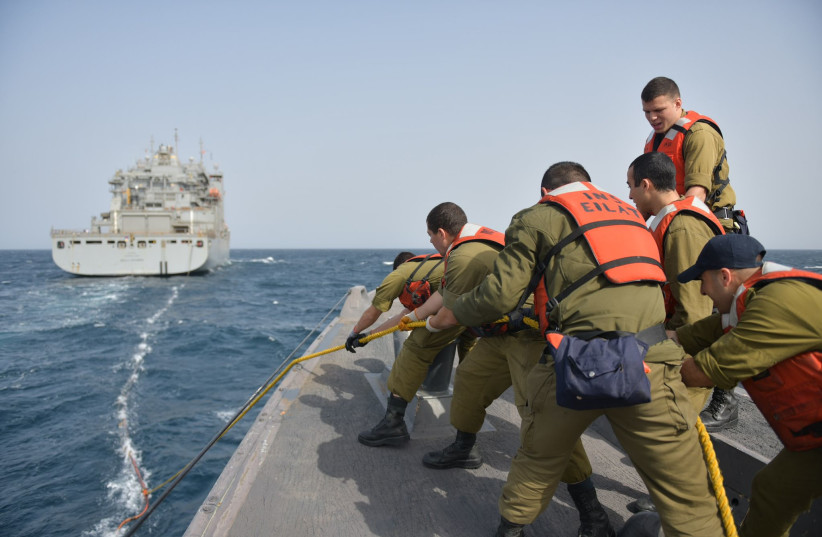The Israel Navy has completed a large-scale exercise with its American counterparts from the US Fifth fleet, drilling on naval combat, maritime refueling and maritime medical scenarios.
The 10-day bilateral drill dubbed “Intrinsic Defender” focused on maritime security operations, explosive ordnance disposal, health topics, and the integration of unmanned systems.
More than 300 personnel from each country participated in the drill, making it the largest drill ever between the Israel Navy and US Fifth Fleet, the IDF said.
Teams from the navy’s Underwater Mission Unit and its Snapir (Fin) Unit (Visit, Board, Search and Seizure) took part in the drill alongside a US Navy explosive ordnance disposal dive team, a US Coast Guard maritime engagement team and global health engagement team.
The US Navy guided-missile destroyer USS Cole, dry cargo ship USNS Wally Schirra and various unmanned vessels also took part in the exercise.

The Underwater Mission Unit drilled on neutralizing naval mines in Eilat Bay as well as neutralizing explosives using unmanned vessels at the Haifa Naval Base. The Snapir Unit meanwhile drilled with the US Coast Guard on taking over vessels and “preventing hostile terror activity.”
The drill also saw medical personnel set up a maritime field hospital on a Sa’ar 6 missile ship – the largest and newest vessel in the Israel Navy. Personnel held workshops, practiced rescue scenarios and set up an operating room on the missile ship.
Navy crews also practiced naval combat in the Gulf of Eilat and the Red Sea, naval firing exercises and vessel protection, and for the first time, the missile ships were refueled by an American tanker in the Red Sea, “which increases the Israel Navy’s operational range and abilities,” the IDF said.
The military said the drill was “another example of the close cooperation between the Israel Navy and the US Fifth Fleet.”
It “provided an opportunity for mutual learning, sharing operational capabilities and strengthening the strategic partnership between the two militaries,” the IDF said, adding that the exercise “brought forth new capabilities to the Israel Navy that increase its operational capacities in both routine and emergency situations.”
A joint briefing was held last week in the Red Sea region led by Israeli Navy V.-Adm. David Saar Salama and US Navy V.-Adm. Brad Cooper, commander of US Naval Forces Central Command.
Salama said that not only is the cooperation with the Fifth Fleet “intensifying,” but that Intrinsic Defender “expands the range of action and operational capability of the navy.”
“The exercise is important and significant for our strategic stability in the maritime arena,” Salama said.
The US Fifth Fleet’s area of operations encompasses some 2.5 million square miles and includes the Arabian Gulf, Gulf of Oman, Red Sea, parts of the Indian Ocean and three critical choke points at the Strait of Hormuz, the Suez Canal and the Bab al-Mandab Strait.
Israel formally moved from US European Command (EUCOM) to CENTCOM in September, a move that is believed to not only simplify the cooperation with American troops in the region, but can also create the potential for a regional coalition with Arab countries that have normalized ties with the Jewish state against shared threats posed by Iran.
Israeli troops have held several drills with CENTCOM, the United States Air Force Central Command (AFCENT) and NAVCENT since the move, including one in November with Bahrain and the United Arab Emirates in the Red Sea.
In February, the navy took part in the biennial International Naval Exercise led by the US Naval Forces Central Command, which saw the participation of more than 9,000 personnel and up to 50 ships from more than 60 militaries and international organizations.
The exercise focused on unmanned naval systems and the use of artificial intelligence.
Though Israel and the US Navy have worked closely together for decades, Cooper told The Jerusalem Post in Bahrain at the beginning of the February drill that “the Abraham Accord signing and the shift to CENTCOM by Israel from EUCOM – and now us taking advantage of that orientation to strengthen maritime security – those two things didn’t exist before and they exist now, and we will take advance of that.”
